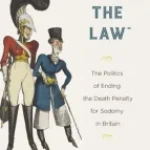American Roulette: The Social Logic of Death Penalty Sentencing Trials
 Author: Sarah Beth Kaufman
Author: Sarah Beth Kaufman
Publisher: University of California Press, 2022. 260 pages.
Reviewer: Matthew West | June 2023
A learning objective in many of the courses I teach emphasizes an assessment of law and justice in principle and law and justice in practice. Kaufman begins American Roulette illustrating the juxtaposition. One might surmise from a half-century of capital punishment jurisprudence that those condemned to death are carefully and thoughtfully selected and judged, articulable on the basis of facts, reason, and fundamental moral intuition. Yet, a serial killer can be sentenced to life imprisonment while a person who committed a murder in the course of a robbery is sentenced to death; of the many people convicted of reprehensible murders each year in the U.S., a death sentence is imposed upon “a capriciously selected random handful.” Furman v. Georgia, 408 U.S. 238, 309-10 (1972). How can this be? The answer, according to Kaufman, is that “capital sentencing…is locked into practices defined by adversary and performance rather than justice or compassion.” Sarah Beth Kaufman, American Roulette: The Social Logic of Death Penalty Sentencing Trials 4 (2020). Kaufman uses the metaphor of Russian roulette, whereas Justice Stewart used the metaphor of lightning strikes. Although both capture the randomness of death sentences, the latter is an “act of nature” whereas the former is an “act of man”. The distinction is notable because, as Kaufman argues, a death sentence is not an outcome of a process outside of human control, it is just the opposite.
The book is organized in two sections, one that sets the stage and one that illustrates the performance. It is a fitting characterization, as Kaufman’s analysis is largely dramaturgical in nature. The first section includes three chapters outlining the major structuring logics—how capital defendants are selected, how capital sentencing is governed, and the key actors in the capital sentencing field. Much of what is in this first section can be found in other texts on the death penalty, but is presented through a unique lens. In a sense, the lens is metalogical, emphasizing the latent meaning and ways of thinking that undergird the capital punishment system. The second section includes four chapters outlining the major performances—the jury performing punitiveness, the defense and prosecutor performing their cases, and co-victims performing quasi-funeral rites. These chapters are largely based on Kaufman’s observations of capital trials. Like the first section, much of what is in this second section can be found in other texts, but Kaufman offers a refreshing perspective that reveals novel insights and implications. A notable strength of the book is its appeal to a wide variety of audiences. It could be a required or supplement text for undergraduate or graduate courses, but it would also be digestible to a member of the public with an interest in the death penalty. Regardless of a reader’s preexisting knowledge of the death penalty, there is something to be gained.
In my view, the most provocative and fundamental theme of the book is that what is missing from the law and legal record is as important, and perhaps more important, than what is present. Court transcripts are analogous to movie scripts. Sometimes the most evocative scenes in a film have few or no words, just as the most evocative moments in a capital trial might involve few or no words. What I find to be one of the greatest strengths of the book is that the Kaufman places the reader in scenes—we watch a victim’s relative sob on the stand and we hear a prosecutor joking with a judge. It is one thing to know, but another to feel, that the administration of justice is an “all too human” act. Legal records capture only a slice of courtroom dynamics, interactions (and the factors that shape them) that might play a pivotal role in the outcome of a trial, but also the more seemingly mundane aspects, like the appearance of an expert witness and a pat on the arm of a co-victim. In turn, much is missed discussions, debates, and even the reasoning undergirding Supreme Court decisions.
In many ways, the theme is reminiscent of legal realism and its precursors. The law in principle cannot be divorced from the law in effect, and, in effect, Kaufman characterizes capital sentencing as a staged, adversarial performance guided by both legal and extralegal norms. The theme also reflects the “inhabited institutions” perspective. Courts are “inhabited” by people who interact to produce outcomes. Jeffery T. Ulmer, Criminal Courts as Inhabited Institutions: Making Sense of Difference and Similarity in Sentencing, 48 Crime & Just. 483, 483-522 (2019). Rather than focusing on and isolating the discretion of particular courtroom actors, Kaufman focuses on the interactions, their structure and content. In so doing, the reader is provided with a rich and vibrant picture, one that is rare to find in scholarship.
At the end of the book, Kaufman reaches two conclusions. The first is that there should be more courtroom ethnographies, from criminal courts to problem-solving courts. It is easy to agree after reaching the end of the book, as it is easy to see how such an approach illuminates and provides insights even in an area that has received decades of scholarly attention. Several implications for practice could come from this work. For instance, best practices for presenting mitigation. The importance of mitigation in sentencing has long been noted, e.g., Edward W. Cox, The Principles of Punishment: As Applied in the Administration of the Criminal Law by Judges and Magistrates (1877); Blackstone’s Commentaries on the Law (Bernard C. Gavit ed., Washington Law Book Co. 1941), but studies illustrate that it is often misunderstood and can even “backfire.” E.g., Craig Haney, Death by Design: Capital Punishment as a Social Psychological System (2005); Lauren N. Miley et al., An Examination of the Effects of Mental Health Disorders as Mitigating Factors on Capital Sentencing Outcomes, 38 Behav. Sci. & L. 381, 381-405 (2020). If, as chapter 5 implies, the intended effect of mitigation is contingent upon the performance, then perhaps training would help minimize the gap between sentencing in principle and sentencing in practice. Findings from courtroom ethnographies might also influence policy, though there is a history of courts being rather dismissive of social science. E.g., Lockhart v. McCree, 476 U.S. 162 (1986); McCleskey v. Kemp, 481 U.S. 279 (1987).
While the first conclusion I find easy to agree with, the second conclusion, that the death penalty should be abolished, I have conflicting feelings about. The realm of science is the empirical, not the normative—the “what is”, not the “what ought to be.” Cf. Brian Leiter, Marxism and the Continuing Irrelevance of Normative Theory, 54 Stan. L. Rev. 1129, 1129-51 (2002). As the philosopher Thomas Nagel once wrote, “moral judgement[s]…certainly apply to public questions, but they are notably ineffective.” Thomas Nagel, Moral Questions, at xii, xiii (1979). In making an exhortation to abolish the death penalty, Kaufman is in good company. E.g., Brandon L. Garrett, End of Its Rope: How Killing the Death Penalty Can Revive Criminal Justice (2017); Timothy Griffin, Comparing Expert Versus General Public Rationale for Death Penalty Support and Opposition: Is Expert Perspective on Capital Punishment Consistent with Disciplined Retention?, 23 Punishment & Soc’y 557, 557-77 (2021). Yet, the death penalty persists. Advocacy for death penalty abolition has contributed to the normalization of life without parole, “death by prison,” see Michelle Miao, Replacing Death with Life? The Rise of LWOP in the Context of Abolitionist Campaigns in the United States, 15 Nw. J. L. & Soc. Pol’y 173, 173-223 (2020); Marion Vannier, Normalizing Extreme Imprisonment: The Case of Life Without Parole in California (1972-2012), 24 Theoretical Criminology 519, 519-39 (2021), a sentence that affects far more people than the death penalty and is less regulated. See, e.g., Ashley Nellis, No End in Sight: America’s Enduring Reliance on Life Imprisonment, Sent’g Project (2021). Qualms with perforating an empirical piece with normative judgement aside, I think the main issue is that, because the preceding parts of the book are so cohesive and cogent, the normative turn at the end of the book feels facile. For example, Kaufman writes, “Criminal punishment is meant to distinguish between those who have acted in illegal ways and those that have not. But is impossible to pretend, in the twentieth century, that this is what the US criminal justice system accomplishes.” Sarah Beth Kaufman, American Roulette: The Social Logic of Death Penalty Sentencing Trials 185 (2020). A fundamental axiom of the U.S. system—with roots in Enlightenment philosophy and English common law, see Blackstone’s Commentaries on the Law (Bernard C. Gavit ed., Washington Law Book Co. 1941)—is that it is better that ten guilty people go free than one innocent is punished. Thus, at best, criminal punishment distinguishes between those who are likely to not be innocent (i.e., people for whom there is a reasonable basis to infer guilt) from everyone else. As Kaufman points out in the beginning of the book, roughly 40% of aggravated homicides are not solved; the primary determinant of whether homicides are solved is evidence. E.g., Phillip J. Cook et al., Why Do Gun Murders Have a Higher Clearance Rate than Gunshot Assaults?, 18 Criminology & Pub. Pol’y 525, 525-51 (2019). As aforementioned, a central theme of the book is that what is missing from the official record is as important, if not more important, than what is contained in the official record. Yet, when considering the death penalty as a matter of policy, Kaufman does not thoroughly apply the same lens, nor more generally approach the normative question with as much rigor as is displayed in the approach to empirical questions.
Nevertheless, I appreciate Kaufman’s concluding challenge to imagine a justice system that “facilitate[s] understandings of commonality rather than exploitation of difference.” Sarah Beth Kaufman, American Roulette: The Social Logic of Death Penalty Sentencing Trials 191 (2020). Slavoj Žižek suggests that societal transformation occurs by people not only imagining but enacting a better world. To some degree, it is fitting that the reader experiences the “what is” through the author’s observations and is then challenged to consider the “what if”. Kaufman recounts an interaction between a victim’s sister and a defendant’s friend that would be mundane in virtually any other context—two people connecting in conversation, sharing interests and experiences. It is worth imagining a justice system that affirms and facilitates the “better angels of our nature” rather than exploiting our “demons”. Like perspectives such as therapeutic jurisprudence, David B. Wexler, Therapeutic Jurisprudence: The Law as a Therapeutic Agent (1990), and restorative justice, John Braithwaite, Crime, Shame and Reintegration (1989), Kaufman pushes readers to imagine and enact a system based on healing and reconciliation. What if the justice system alleviated and mended the suffering of individuals, communities, and the larger society rather than exploiting and exacerbating it? Ultimately, the current system was built by human hands; human hands can build a better one.
References
Sarah Beth Kaufman, American Roulette: The Social Logic of Death Penalty Sentencing Trials (2020)
Furman v. Georgia, 408 U.S. 238, 309-10 (1972)
Jeffery T. Ulmer, Criminal Courts as Inhabited Institutions: Making Sense of Difference and Similarity in Sentencing, 48 Crime & Just. 483, 483-522 (2019)
Edward W. Cox, The Principles of Punishment: As Applied in the Administration of the Criminal Law by Judges and Magistrates (1877)
Blackstone’s Commentaries on the Law (Bernard C. Gavit ed., Washington Law Book Co. 1941)
Craig Haney, Death by Design: Capital Punishment as a Social Psychological System (2005)
Lauren N. Miley et al., An Examination of the Effects of Mental Health Disorders as Mitigating Factors on Capital Sentencing Outcomes, 38 Behav. Sci. & L. 381, 381-405 (2020)
Lockhart v. McCree, 476 U.S. 162 (1986)
McCleskey v. Kemp, 481 U.S. 279 (1987)
Brian Leiter, Marxism and the Continuing Irrelevance of Normative Theory, 54 Stan. L. Rev. 1129, 1129-51 (2002)
Thomas Nagel, Moral Questions, at xii, xiii (1979)
Brandon L. Garrett, End of Its Rope: How Killing the Death Penalty Can Revive Criminal Justice (2017)
Timothy Griffin, Comparing Expert Versus General Public Rationale for Death Penalty Support and Opposition: Is Expert Perspective on Capital Punishment Consistent with Disciplined Retention?, 23 Punishment & Soc’y 557, 557-77 (2021)
Michelle Miao, Replacing Death with Life? The Rise of LWOP in the Context of Abolitionist Campaigns in the United States, 15 Nw. J. L. & Soc. Pol’y 173, 173-223 (2020)
Marion Vannier, Normalizing Extreme Imprisonment: The Case of Life Without Parole in California (1972-2012), 24 Theoretical Criminology 519, 519-39 (2021)
Ashley Nellis, No End in Sight: America’s Enduring Reliance on Life Imprisonment, Sent’g Project (2021)
Phillip J. Cook et al., Why Do Gun Murders Have a Higher Clearance Rate than Gunshot Assaults?, 18 Criminology & Pub. Pol’y 525, 525-51 (2019)
David B. Wexler, Therapeutic Jurisprudence: The Law as a Therapeutic Agent (1990)
John Braithwaite, Crime, Shame and Reintegration (1989)
Matthew P. West is an Assistant Professor in the Department of Criminology and Criminal Justice at Southern Illinois University.


